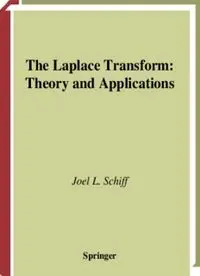
The Laplace Transform: Theory and Applications PDF
Preview The Laplace Transform: Theory and Applications
The Laplace Transform: Theory and Applications Joel L. Schiff Springer To my parents v It is customary to begin courses in mathematical engineering by ex- plaining that the lecturer would never trust his life to an aeroplane whose behaviour depended on properties of the Lebesgue integral. It might, perhaps, be just as foolhardy to fly in an aeroplane de- signed by an engineer who believed that cookbook application of the Laplace transform revealed all that was to be known about its stability. T.W. Ko¨rner Fourier Analysis Cambridge University Press 1988 vii Preface The Laplace transform is a wonderful tool for solving ordinary and partial differential equations and has enjoyed much success in this realm. With its success, however, a certain casualness has been bred concerning its application, without much regard for hypotheses and when they are valid. Even proofs of theorems often lack rigor, and dubious mathematical practices are not uncommon in the literature for students. In the present text, I have tried to bring to the subject a certain amount of mathematical correctness and make it accessible to un- dergraduates. To this end, this text addresses a number of issues that are rarely considered. For instance, when we apply the Laplace trans- form method to a linear ordinary differential equation with constant coefficients, any(n) + an−1y(n−1) + · · · + a0y f (t), why is it justified to take the Laplace transform of both sides of the equation (Theorem A.6)? Or, in many proofs it is required to take the limit inside an integral. This is always frought with danger, especially with an improper integral, and not always justified. I have given complete details (sometimes in the Appendix) whenever this procedure is required. ix Preface x Furthermore, it is sometimes desirable to take the Laplace trans- form of an infinite series term by term. Again it is shown that this cannot always be done, and specific sufficient conditions are established to justify this operation. Another delicate problem in the literature has been the applica- tion of the Laplace transform to the so-called Dirac delta function. Except for texts on the theory of distributions, traditional treatments are usually heuristic in nature. In the present text we give a new and mathematically rigorous account of the Dirac delta function based upon the Riemann–Stieltjes integral. It is elementary in scope and entirely suited to this level of exposition. One of the highlights of the Laplace transform theory is the complex inversion formula, examined in Chapter 4. It is the most so- phisticated tool in the Laplace transform arsenal. In order to facilitate understanding of the inversion formula and its many subsequent applications, a self-contained summary of the theory of complex variables is given in Chapter 3. On the whole, while setting out the theory as explicitly and carefully as possible, the wide range of practical applications for which the Laplace transform is so ideally suited also receive their due coverage. Thus I hope that the text will appeal to students of mathematics and engineering alike. Historical Summary. Integral transforms date back to the work of Le´onard Euler (1763 and 1769), who considered them essentially in the form of the inverse Laplace transform in solving second-order, linear ordinary differential equations. Even Laplace, in his great work, The´orie analytique des probabilite´s (1812), credits Euler with introducing integral transforms. It is Spitzer (1878) who attached the name of Laplace to the expression ∫ b sx y e φ(s) ds a employed by Euler. In this form it is substituted into the differential equation where y is the unknown function of the variable x. In the late 19th century, the Laplace transform was extended to its complex form by Poincare´ and Pincherle, rediscovered by Petzval, Preface xi and extended to two variables by Picard, with further investigations conducted by Abel and many others. The first application of the modern Laplace transform occurs in the work of Bateman (1910), who transforms equations arising from Rutherford’s work on radioactive decay dP − λiP, dt by setting ∫ ∞ −xt p(x) e P(t) dt 0 and obtaining the transformed equation. Bernstein (1920) used the expression ∫ ∞ −su f (s) e φ(u) du, 0 calling it the Laplace transformation, in his work on theta functions. The modern approach was given particular impetus by Doetsch in the 1920s and 30s; he applied the Laplace transform to differential, integral, and integro-differential equations. This body of work cul- minated in his foundational 1937 text, Theorie und Anwendungen der Laplace Transformation. No account of the Laplace transformation would be complete without mention of the work of Oliver Heaviside, who produced (mainly in the context of electrical engineering) a vast body of what is termed the “operational calculus.” This material is scattered throughout his three volumes, Electromagnetic Theory (1894, 1899, 1912), and bears many similarities to the Laplace transform method. Although Heaviside’s calculus was not entirely rigorous, it did find favor with electrical engineers as a useful technique for solving their problems. Considerable research went into trying to make the Heaviside calculus rigorous and connecting it with the Laplace trans- form. One such effort was that of Bromwich, who, among others, discovered the inverse transform ∫ γ+i∞ 1 ts X(t) e x(s) ds 2πi γ−i∞ for γ lying to the right of all the singularities of the function x.
